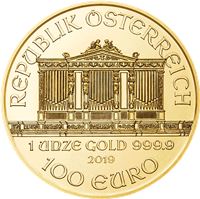Austrian Gold Coins
- Gold
- Silver
- Platinum
- Palladium
- 1 gram
- 2.5 gram
- 5 gram
- 10 gram
- 50 gram
- 100 gram
- 250 gram
- 1/20 oz
- 1/10 oz
- 1/5 oz
- 1/4 oz
- 1/2 oz
- 1 oz
- 2 oz
- 5 oz
- 10 oz
- 20 oz
- 50 oz
- 100 oz
- 1/2 kilo
- 1 kilo
- 5 kilo
- 10 kilo
Austrian Gold Coins
The Austrian mint, with an 820-year history, is renowned for its quality coins and its rather curious foundational story. The mint, which mints well-known coins such as the silver thaler, also produces precious gold coins and re-strikes previously-circulated coins as well. Austria produces the following illustrious coins: The Gold Philharmonic, gold Ducats, gold Florins, as well as other previously-circulated Austrian gold coins such as the 1915 Austrian 4 Ducat.
The Austrian Mint and Richard the Lionheart
In 1194, Richard the Lionheart, upon his return to England from the crusades, was captured near Vienna by Duke Leopold V. As honor was an important matter in the 12th century CE, Duke Leopold V had been insulted by Richard the Lionheart and therefore captured him in order to restore his own honor. In order for King Richard to regain his freedom from the Austrian Duke, Richard the Lionheart was forced to pay a 12 tonne ransom in silver. These 12 tonnes translate into just over 6 million dollars worth of gold by today's standards.
With this enormous amount of precious metals, the Duke decided it would be best to begin to strike coins. This process led to the establishment of the Austrian Mint. The mint would not be mentioned in written records for another 200 years, but nevertheless, it was a major producer of European coins.
The Gold Philharmonic Coin
On October 10th, 1989, the Austrian mint debuted its Gold Philharmonic Coin. The Austrian Philharmonic coin is sometimes referred to as the Vienna Philharmonic and is one of the most globally popular European coins. The coin, having ranked second and third in global popularity in the last few years, continues to impress coin collectors and precious metal investors alike.
Unsurprisingly, the Philharmonic illustrates the Vienna philharmonic's principal instruments on the reverse and one instrument on the obverse. Among the instruments on the reverse are the Vienna horn, the bassoon, the harp, the cello, and four violins. The obverse features the Musikverein Pipe Organ. The Austrian Mint's Gold Philharmonic bullion series is a .999 or 24 karat gold bullion coins series. Like other modern gold bullion coins from National Mints, the Gold Philharmonic is available in 1 ounce, 1/2 ounce, 1/4 ounce, and 1/10 ounce sizes.
The "Big Phil"
For the Philharmonic's 15th anniversary in 2004, the Austrian mint debuted the "Big Phil." The "Big Phil," was a 1,000 ounce Vienna Philharmonic gold coin with a denomination of €100,000. This face value was the largest denomination ever produced up to this point. It wasn't until the Canadian Royal Mint debuted a 1,000,000 Canadian dollar denominated coin in 2007, that it lost the title of largest face value.






